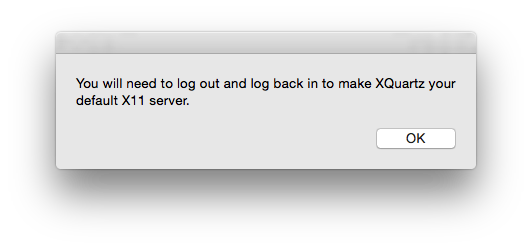

Move the new Distribution file into the expanded package Modify the Distribution file inside of the expanded package, to allow installation to occur (regardless of the system version):Ĭat ~/Desktop/XQuartz/Distribution | sed s/false/true/g > ~/Desktop/Distribution

Sudo pkgutil -expand /Volumes/XQuartz-2.7.4/XQuartz.pkg ~/Desktop/XQuartz Hdiutil mount ~/Desktop/XQuartz-2.7.4.dmgĮxpand the package into a folder name XQuartz on the Desktop: Mount the XQuartz-2.7.4.dmg disk image (assuming that it's on the Desktop):
#Update xquartz install#
It may be possible to modify the package's Distribution file to allow it to install correctly: Although the contents of /System/Library/CoreServices/ist shows that the value of ProductVersion is set to '10.8.5', the installer does not see it this way. The installer is not recognizing the system as the correct version.
#Update xquartz update#
Installer: This update requires you to first update your system to OS-X 10.6.3 This is based on the following error message that occurred when attempting to use installer in Terminal: installer: Cannot install on volume / because it is disabled. You will need to make sure that you have the XQuartz disk image mounted before performing this command: sudo installer -pkg /Volumes/XQuartz-2.7.4/XQuartz.pkg -target /Īpparently, the XQuartz installer is not allowing installation on the boot drive because it is failing some pre-installation checks.
#Update xquartz software#
#Update xquartz windows#
New attempts to open windows will just fail after that.

It's also important to note that "untrusted" X11 forwarding turns off after a certain amount of time to keep you from accidentally leaving it on. Do you need to be able to rotate your X display from the remote host? This is probably why RandR is disabled with -X. "Untrusted" is the one that makes it (somewhat) safer to deal with an untrusted remote host.Īn "Untrusted" connection attempts to limit what a black hat could do to you by engaging the X11 security extension and disabling other extensions that you (hopefully) don't need. But actually it's an option you're supposed to use in situations where the connection IS trustworthy and you want to run stuff without extra security measures getting in your way. I thought "Trusted" connections were safer. This terminology actually confused me for years. "Trusted" means you are entirely confident that no on on the remote host will get access to your Xauth data and use it to monitor your keystrokes for instance. SSH will use additional security measures to try to make X11 forwarding safer. "Untrusted" in this context means you don't trust the connection.


 0 kommentar(er)
0 kommentar(er)
